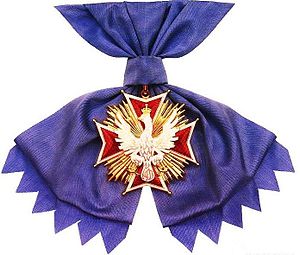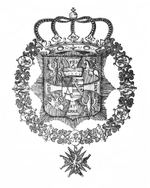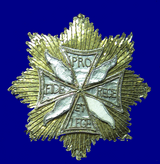Order of the White Eagle (Poland)
| Order of the White Eagle Order Orła Białego | |
|---|---|
 | |
| Awarded by the President of Poland (previously King of Poland) | |
| Type | Single grade order |
| Established | 1 November 1705 |
| Country | |
| Motto |
|
| Eligibility | All |
| Status | Currently awarded |
| Grand Master | President of Poland Andrzej Duda |
| Statistics | |
| Total inductees | 355 (since 1921) |
| Precedence | |
| Next (higher) | none - highest award |
| Next (lower) | Order Virtuti Militari |
The ribbon bar of the Order | |
The Order of the White Eagle (
The Order of the White Eagle is attached to a purple ribbon slung over the left shoulder to the right side. The star of the Order, formerly embroidered, is worn on the left side of the chest.[2]
History
The badge of the Order of the White Eagle was originally a red
Initially, the creation of the Order was strongly opposed by many of the Polish nobility, since membership in the Order conferred a distinction which violated the traditional equality of all Polish nobles. Since the Order had no patron saint, Augustus II made 2 August the feast of the Order. His son, Augustus III, however, changed the Order's feast day to 3 August.
Under the
After Russian troops put down the
The Order of the White Eagle officially became Poland's highest decoration by act of Parliament of 4 February 1921, and the insignia was redesigned. During the interbellum (1921-1939), the Order was awarded to 24 Polish citizens and 87 foreigners, among whom were 33 monarchs and heads of state, 10 prime ministers and 15 other ministers of state, and 12 members of royal families.
After 1948, when the
1713 Insignia

The 1713 badge was a Maltese cross enameled red with white borders with diamonds set in each of the balls at the eight points of the cross and with diamond set rays appearing between each of the points of the cross, i.e., a larger longer ray between each arm of the cross and a smaller ray between each of the two points of these arms. In the centre of the cross was a white enamelled eagle in high relief with spread wings and facing left and with a diamond set royal crown on its head. At the top of the cross between the two top points was a diamond studded semi-circular link through which passed a diamond studded ring through which, in turn, passed the light-blue ribbon from which it was worn. The reverse side of this Maltese cross was enamelled white with red borders and had at its center an oval gold medallion with the founder's crowned




